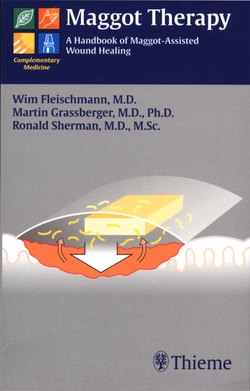Читать книгу Maggot Therapy - Martin Grassberger - Страница 8
На сайте Литреса книга снята с продажи.
Оглавление3 Maggots and Wound Healing
History of Maggot Therapy
Fig. 10 Woodcut from Hortus Sanitatis, 1491.
My body is covered with worms and scabs,
My skin is broken and festering.
(Old Testament, Job 7:5, NIV Version, 1984)
The benefical effects of maggots on wounds have been recognized for centuries. Australian Aborigines used maggots to clean wounds for thousands of years. Military physicians stationed in Burma during World War II observed the medical use of maggots by the local residents. The Burmese traditionally placed maggots in wounds and covered them with mud and wet grass. Historic records indicate that Mayan Indians wrapped wounds with cloths soaked in animal blood and dried in the sun. The pulsating activity of maggots was soon observed beneath the wound dressings.
Military surgeons frequently observed and described the benefits of maggots infesting the wounds of fallen soldiers. The best known accounts are those of the French military surgeon Ambroise Pare (1510-1590), who reported on the Battle of Saint Quentin (1557), and the French surgeon Baron Dominique-Jean Larrey (1766-1842), who described his observations treating Napoleon's injured soldiers during an expedition to Egypt (1799).
Although his accounts tended to emphasize the negative, destructive nature of maggots, Ambroise Pare also described remarkably quick recoveries in his maggot-infested patients. However, Pare did not attribute this to the maggots, nor did he realize that the “worms” were, in fact, fly larvae. Like most of his contemporaries, Pare believed that maggots developed spontaneously as part of the putrefaction process of devitalized necrotic tissue.
Fig. 11 Ambroise Pare (1510-1590), described quick wound healing in maggot-infested soldiers.
Napoleon's surgeon, Baron Dominique-Jean Larrey, recognized that “blue fly” maggots only removed dead tissue, after observing their beneficial effects on wounds. Larrey and his medical staff attempted to convince the soldiers that the maggots had a beneficial effect on the wounds, removing necrotic tissue and accelerating the natural healing process.
The American Civil War
John Forney Zacharias (1837-1901), a Confederate army surgeon during the American Civil War, was probably the first physician to intentionally expose festering wounds to maggots. According to Chernin (1986), Zacharias wrote,
“During my service in the hospital at Danville, Virginia, I first used maggots to remove the decayed tissue in hospital gangrene and with eminent satisfaction. In a single day, they would clean a wound much better than any agents we had at our command. I used them afterwards at various places. I am sure I saved many lives by their use, escaped septicemia, and had rapid recoveries.”
During this same time in the Northern hospitals, Union soldiers were having their wounds cleaned and dressed frequently, while the wounds of Confederate soldiers were left unkempt and maggot-borne. Reportedly, the flyblown wounds of the Confederate soldiers healed more quickly than those of the Union soldiers, and the Confederate soldiers were more likely to survive their wounds than were the Union soldiers.
William W. Keen (1837-1932), a Union army surgeon, noted the presence of maggots in wounds and commented that, in spite of their revolting appearance, the maggots evidently were not detrimental to the healing process (Goldstein, 1931). Still, the therapeutic application of maggots was hardly ever practiced by Union surgeons. The Confederate surgeons, on the other hand, often did not have any other choice since they rarely had enough dressing materials at their disposal (Adams, 1952). Joseph Jones (1833-1896), a Confederate doctor, wrote:
“I have frequently seen neglected wounds...filled with maggots... as far as my experience extends, these worms only destroy dead tissues and do not injure specifically the well parts.” {Cited after: Cunningham, 1970)
The germ theory put forward by Robert Koch and Louis Pasteur in the 1880's revolutionized medicine in that it introduced the novel concept of hygiene-oriented practice, which forbade doctors to allow bacterially contaminated products to get anywhere near an open wound. Likewise, the development of antiseptic techniques completely reformed the field of surgery. Therefore, no physician practicing in the late 19th and early 20th century was willing to publicly propagate the idea of using unsterilized maggots.
World War I
William S. Baer, an American surgeon stationed in France during World War I, cared for two soldiers who lay injured on the battlefield for seven days before being discovered. By then, their wounds were teeming with maggots. Baer removed the maggots and observed, much to his surprise, that the wound beds were not filled with pus, but rather with healthy, newly formed granulation tissue. At that time, the mortality rate for soldiers similarly injured was 70 %. Baer recounts:
